Want the good news first?
The just-redesigned Nissan Frontier pick-up not only still comes with a V6 – it’s standard. Some of the others in this class – like the Chevy Colorado – come standard with a four. One of the others in this class – the Ford Ranger – comes only with a four.
Ready for the bad?
There’s no option to buy a less expensive four, which the previous Frontier used to come standard with – along with a much lower base price.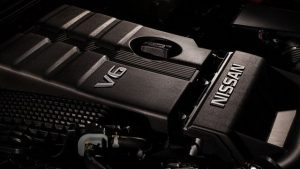
And – just like almost all the other trucks in this class – there’s no longer an option to shift for yourself.
What It Is
The Frontier is Nissan’s mid-sized pick-up truck. It competes with the other mid-sized trucks in the class, including the Ford Ranger, Toyota Tacoma and the GM twins, the Chevy Colorado and its GMC-badged brother, the Canyon.
Prices start at $27,840 for a base S trim King Cab with 2WD with a six foot bed. Adding 4WD bumps the sticker price to $31,040.
Crew cabs – with four doors – start at $29,340 for the base trim with 2WD and you can choose either a six foot or a five-foot bed. Adding 4WD bumps the sticker price to $32,340.
The range tops out at $37,240 for a PRO-4X trim (Crew cab only) with 4WD. This one comes with more ground clearance than the other trims (9.8 inches vs. 8.9 inches), Bilstein shocks, a locking rear differential, all-terrain tires and underbody skid plates.
What’s New
The ’22 Frontier has been redesigned from the treads up.
What’s Good
Powerful V6 is standard – and the most powerful V6 in the class.
Near full-sized towing capacity (6,720 lbs.)
Accessible bed – vs. current full-sized trucks.
What’s Not So Good
No basic Work Truck version offered.
Almost as big as a full-sized truck used to be.
No more option to change gears yourself.
Nissan bucks the trend toward ever-smaller engines in ever-larger vehicles, including trucks. Including some of the Frontier’s four-cylinder-only competition, such as the Ford Ranger. The Frontier comes standard with a V6 – an engine that used to be the Frontier’s optional engine – and which was available with either a manual six speed transmission or (optionally) a five speed automatic transmission.
The standard Frontier engine was a 2.5 liter four cylinder engine, which was also available with either the manual or the automatic transmission.
The new Frontier comes only with a 3.8 liter V6 – paired only with a nine speed automatic, in keeping with the trend toward automatic-only everything. Including trucks. The Ford Ranger and GM Colorado/Canyon twins are also automatic-only. The rumor is that the Toyota Tacoma – which is the only remaining pick-up you can still pick up with a manual (paired only with its optional V6) will also be automatic-only, soon.
On the upside, there is more standard power – 310 horses, most in the class – and capability. The current Frontier can pull more than 6,700 pounds or almost twice what the old four cylinder-powered Frontier could pull. It is also much quicker, as it comes.
Zero to 60 in about 8 seconds – vs. about two seconds longer for the old four cylinder Frontier.
There’s another upside, too. The V6 doesn’t use much more gas than the previously standard four: 18 city, 24 highway vs. 19 city, 23 highway, the latter with the formerly available five speed manual transmission.
That’s the benefit of having another four gears – three of them (7th, 8th and 9th) being overdrive gears, which reduce engine speed relative to road speed – which is how you get 24 on the highway out of a 310 hp V6 vs. 23 on the highway from a 152 horsepower four.
On the downside . . .
While you pay less – or at least, not appreciably more – for gas and get much more horsepower, you pay much more for it.
The least expensive version of the ’22 Frontier is almost $28k – for the 2WD version. With the optional 4WD system, it’s more than $31k.
For reference, the previous Frontier – with the formerly standard four cylinder engine and manual transmission – stickered for just $18,990
A word about diesel engines – which the Frontier doesn’t offer but which you can get in the GM twins: Their mileage gain is slight – about 30 on the highway, so about 4 MPG better than the Frontier’s gas V6 – but the cost is extremely high. GM only offers the diesel option in the highest trim versions of the twins and bundles it with a whole array of equipment that adds another $3,800 to the tab, pushing the price of a diesel-powered Canyon or or Colorado well over $40k.
On The Road
Who mourns for the lost third pedal?
Truck people used to like to shift for themselves. Especially thrifty truck buyers, who figured it made more sense to pay less for a truck equipped with a manual that maybe didn’t rate the same gas mileage numbers as one with an automatic – but which made up for that by saving them (usually) about $800-$1,000 to buy vs. the same truck with what was formerly the optional automatic.
There was also the chance – if you knew how to shift – of beating the automatic’s posted numbers. 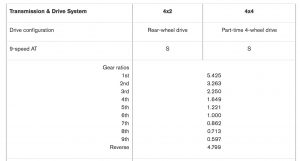
These numbers being more than a little deceptive since they depend on the programming of the automatic, which is programmed to get the transmission into its multiple overdrive gears as soon and as often as possible. The problem with that is that when the transmission jumps up into overdrive 7th or 8th or 9th too soon – for the sake of mileage – performance suffers. There’s not much drivetrain leverage when the transmission is in 0.862 (7th) or 0.713 (8th) or 0.597 (9th) and so the engine – despite its available power – has trouble moving the vehicle responsively when the transmission is in those gears. So you push down harder on the accelerator – and that causes the transmission to drop down 3-4 gears, to give you the leverage needed to get going.
And that changes the numbers.
Over the course of a week of real world driving, the V6-equipped Frontier’s mileage numbers averaged mid-high teens – which is still ok for a 300-plus horsepower truck that is almost a full-sized truck (more on that below).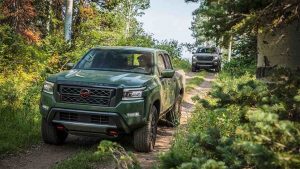
And the power is nice.
This writer owns an older (2002 model) Frontier equipped with the four cylinder engine/manual transmission combo. It is slower than Joe Biden without a TelePrompter . . . but in a trucky kind of way, it’s more appealing to me than this automatic-only Frontier. The feel of the shifter – as opposed to a drive-by-wire selector – vibrating in my right hand, which is physically connected to the transmission, which I – the driver – have total control over. In this Frontier, the transmission decides when it will shift – and when. Even though there is a “manual” gear control function, it is in fact electronically controlled. If the computer wants an up (or down) shift, that’s what will happen – and does.
On the upside, Nissan has programmed the nine speed automatic to shift pretty seamlessly, so much so that it is hard to know – without looking at the digital display – which gear the transmission is in. And if you do tow – or rock crawl – the automatic offers advantages.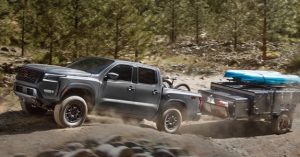
Still, the manual is missed – at least, by me.
Ride quality has been softened up, too. But not so much that this truck rides like a car. It still has leaf springs in the rear, just like the old Frontier. But the upsized size (length/wheelbase/width) vs. the last generation (and compact-sized) Frontier like my ’02 has markedly changed the current Frontier’s manners. My truck practically falls into potholes and feels a bit breezy on the highway.
This Frontier doesn’t – even at much higher than highway speeds.
But it also feels much bigger – at low speeds – because it is.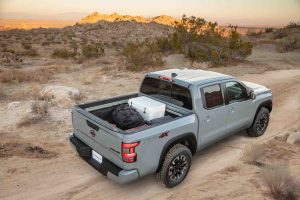
At The Curb
No one makes a compact-sized truck anymore – and the Frontier is no exception. The smallest version of this truck – King Cab with six foot bed – is 210.2 inches long, 73 inches wide, 72 inches tall – and rides on a 126 inch wheelbase.
That’s a pretty big truck.
In fact, it is almost a full-sized truck – at least by recent historical standards. As recently as the 2000 model year, a full-sized (1500) Ford F-150 regular cab was 207.2 inches long and rode on a 120.2 inch wheelbase.
Of course, the current F-150 (and all current 1500s) is super-sized.
But the point remains: There aren’t any small trucks available today. What you can buy is a truck like the Frontier and the others in the class that are as manageable as full-sized trucks used to be, especially as regards loading and unloading them. Current full-size trucks are so jacked up – and have bed walls so high – that it is difficult to load/unload them, without a forklift.
Or a step ladder, to reach what’s in the bed.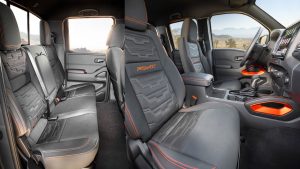
The Frontier’s bed is much more accessible. The downside is that it’s small- relative to the size of the Frontier, itself. The current nearly full-sized Frontier’s bed is only slightly bigger – slightly wider – than my ’02 Frontier’s bed. Put another way, my truck can carry home about the same size load as the new Frontier and it is much more maneuverable than the new one, which takes up as much room to park as a full-sized truck used to.
On the upside, the inside is almost as roomy as full-sized trucks’ insides used to be. Even the King Cab’s back seats are human-usable (in the previous generation compact-sized Frontier, like my ’02 they were useful . . . for your gym bag). If you get the Crew Cab, the back seats have even more room – including 33.2 inches of legroom, as well as the extra set of doors that let passengers get in and out without the driver or passenger having to get out, first.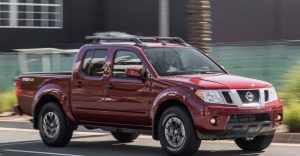
The styling is less distinctively Nissan than it was – and more generically New Truck. It shares a similar blockiness with other trucks in the class, which emulate the look of today’s super-sized trucks. It’s not unattractive – and not over-the-top. But it’s more more homogenous-looking than the previous Frontier, which had those specific-to-it riveted-looking fender flares and a jauntier shape.
The Rest
All Frontiers come with some useful – if not obviously visible – built-in features such as the underseat storage in back and multiple 12V as well as four USB power points, so whatever you’ve got that needs power can be plugged in.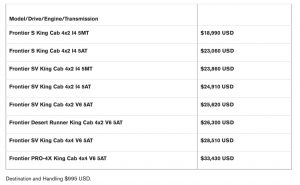
But there’s no regular cab or basic work truck version – another reason for the new Frontier’s pushing $28k base price vs. the old Frontier’s under-$20k base price. Even the base S trim has an 8 inch LCD touchscreen, a six speaker stereo with steering wheel-mounted secondary controls, an “Advanced” 7-inch Driver Assist Display, push-button start, power windows and locks. The only thing not automatic/electronic are the base trim’s outside rearview mirrors – which you still adjust by hand.
Also standard – even in the base S trim – are four wheel disc brakes a limited slip rear axle.
My ’02 Frontier has drum rear brakes and an open (non-locking/limited slip) axle, which you could’t get with the base trim or the four cylinder engine. But just a few years earlier, you could get a regular cab, four cylinder-powered Frontier with a manual transmission and 4WD, with a limited slip rear axle.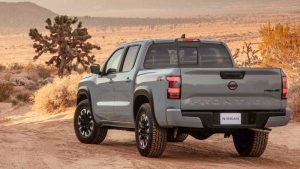
I know, because I used to own one of those.
It was an immensely capable, practical little truck that also cost less than $20k when it was new.
It’s a shame there’s nothing available, new, that’s like that anymore.
The Bottom Line
It’s more truck, in every way – including what it’ll cost you.
. . .
Got a question about cars, Libertarian politics – or anything else? Click on the “ask Eric” link and send ’em in!
If you like what you’ve found here please consider supporting EPautos.
We depend on you to keep the wheels turning!
Our donate button is here.
If you prefer not to use PayPal, our mailing address is:
EPautos
721 Hummingbird Lane SE
Copper Hill, VA 24079
Also, we do accept Crypto. If you’d like to donate that way, please email EPeters952@yahoo.com for details.
PS: Get an EPautos magnet or sticker or coaster in return for a $20 or more one-time donation or a $10 or more monthly recurring donation. (Please be sure to tell us you want a magnet or sticker or coaster – and also, provide an address, so we know where to mail the thing!)
My eBook about car buying (new and used) is also available for your favorite price – free! Click here. If that fails, email me at EPeters952@yahoo.com and I will send you a copy directly!


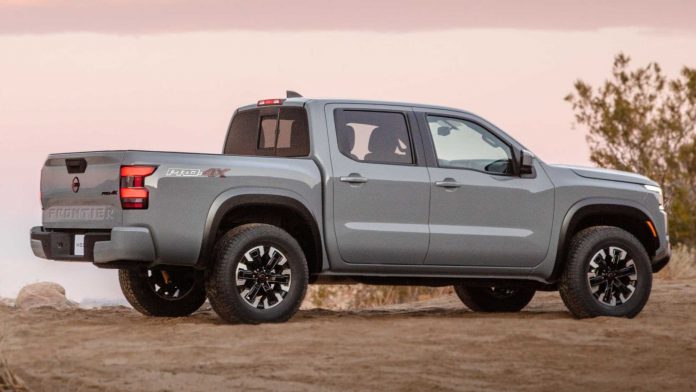

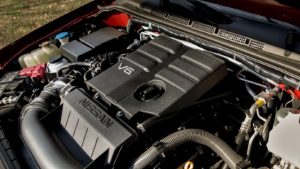
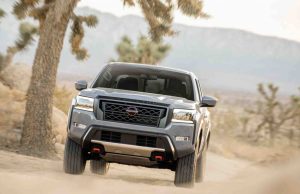







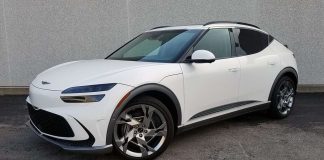
Don’t forget that the Gladiator still has a manual as well, although that really lowers the towing capacity.
What is that popup camper in the Frontier towing picture?!?!
Eric,
Inherited my Dad’s old 98 Frontier. (5spManual). Wonderful truck! Easy to work on.
(Recently replaced water pump myself!)
Kills me that no one makes compact trucks anymore, though it looks like a market for compact trucks exists if you’re willing to go import….
See https://japancardirect.com/mini-trucks-and-kei-turbo-cars/mini-kei-trucks/
Would love to see an article on the death of the compact truck market. Maybe once Fuel prices go way up people will give them a second look.
P.S. – I see Frontiers ALL OVER the place here in FL! They’re Keeping em’!
Whats the track record of that 9 speed transmission???
Might want to look at an extended aftermarket warranty.
Here’s my little story on how mine saved me major bucks.
Have a 2004 Honda Pilot, got new, bought the aftermarket dealer- sold extended warranty, for $1,500, out to 6 years and 100K. Primarily because we had heard horror stories of transmission and possibly engine breaking and cost big to fix, so got it just in case.
And just before the end of warranty at 5 years, 10 months and 92K miles, the transmission was acting wonky and not shifting into OD without shuddering badly.
Dealership diagnosed bad transmission.
First question from warranty company was, “where are receipts for transmission fluid and filter changes? Or we will deny claim if not done in accordance with Honda’s maintenance schedule.”
But, I had read the owners manual and the fine print for the warranty, and had done all maintenance ahead of schedule, with receipts, and the darn thing still went out. The problem was that this transmission doesn’t have a filter, it has a screen, and every shop I talked with, dealerships too, had stories of transmissions locking up and said it was just a poor design.
Warranty covered replacement and the Honda remanufactured transmission was $2,700, remove/replace was $1,100, and $200 in fees.
But because I insisted on a Honda replacement transmission, that had a 3 year/36K factory warranty, and did not want a generic transmission , with only a 1 year/12K warranty for $2,200, I had to fork over an extra $500 out of pocket. Not happy about that, but the extra 2 years/24K miles of warranty, from Honda, made it worth it to me.
All told, would’ve been a $4K repair, out of pocket, but even with warranty cost, it was $2K, all this in 2010.
So, did ok with that, plus it still runs great today, with 136K on replacement transmission, and 228K on engine.
And, yup, I’m still OCD about maintenance on it.
At a certain point, it’s just “cheaper to keep her”and repair it, as when I looked at buying anything else with 4WD, it was big bucks, $35K and up, in 2010.
And today, it’s just insane for what dealers and manufacturers are asking.
And it’s because the US government is requiring, but not forcing them to do it, as manufacturers are happy to make as much money as possible, per unit, but will lose their customer base in the future.
Buy used, it’s what I’ve done for almost 40 years, except for 2 new vehicles in that time, this Honda being one.
I find it funny these so-called compact trucks are as big as a 20 year old fullsize truck!
The Ford Maverick they call it a compact,tiny truck is actually as big as a 1994 Ford F 150 lol….
I prefer bigger vehicles but it’s nice to have a small compact circa 1984 style compact truck,a real compact..Lots of small businesses could use a little truck like that,but oh well I guess!
Hi WTF,
Yup, same here. I have no interest in new half-ton trucks as they are monstrously oversized and cartoonish-looking. It is idiotic that a man my height (I’m 6ft 3) can barely reach the floor of the bed while standing next to these things. That a guy my size needs a ladder to get in the bed. The new mid-sized trucks are manageable but also idiotic in that they are all king/crew cabs with comparatively short beds (5 and 6 feet) which means that while they have an almost full-sized (by early 2000s and prior standards) footprint, they can only carry as much as a compact-sized pickup. This is deliberately done to “encourage” people who need an eight foot bed to buy a half-ton truck.
In re the Maverick: It’s not a hateful thing, but it’s not a truck. More like a higher-riding El Camino, and not even that because it’s front-drive-based.
All of this sounds like installment #104 of “Reasons To Buy and Restore An Old Truck”.
Very surprised that the V6 is standard. Was figuring the V6 would be dropped completely. Guessing Nissan doesn’t actually sell that many pickups both this and the Titan to hurt their CAFE numbers.
‘paired only with a nine speed automatic’ — eric
BZZZT! Disqualified!
Don’t want no nine-speed automatic. My ’98 Frontier has a 5-speed manual. I chopped down its original, ridiculous baseball-bat length shifter — getting rid of its mushy damper too — and now have a nice, short, responsive, all-metallic shift lever.
They’ll have to tear it out of my cold, dead hands.
Like the old KA24DE engine, which produces surprisingly poor fuel economy for a 2.4-liter DOHC four, the 2022 V6’s mileage of 18 city, 24 highway is quite unimpressive and uncompetitive, bordering on a gas hog in contemporary terms. A lot of old carbureted, pushrod-valve engines from 30 years ago can equal those sorry numbers.
Goodbye Nissan — ain’t buyin’ your crap no more.
I agree with everyone else here : New vehicle prices seam more like house money to me. In 1991 I built a house…..59K……Now that will hardly buy a new truck….Crazy town to me. And yes I mourn the death of another Manual trans. New trucks suck.
In general I’m not a Nissan fan but I love the way this one looks! Any chance we could get a review of Maverick and/or Santa Cruz?
Hi Anon,
In re the Maverick and Santa Cruz: I ought to be getting both at some point over the next couple of months – so, yes!
In re the Frontier: I’ve owned several older models and love these trucks. I’m ambivalent about this one. If I were going to buy a new truck in this class, I’d probably buy a Tacoma, V6 with manual. I really dislike automatics – especially the latest more-than-six-speed boxes – not because of their operating characteristics but rather because of my dread of what they will cost to replace when they fail. I’m one of those guys who keeps a vehicle for 20-plus years, so this is a “likely” with an automatic anything vs. a manual almost-anything (which will need a clutch at some point but that’s not a big deal). But a $4k new transmission when then trucks is 13 years old and worth $5k is….
Yeah, I was going to ask the same question. When are you going to review a Maverick? Everything I have seen and read about the Maverick has been positive: it might be a bases-loaded home run for Ford. They have just about filled up production capacity with pre-orders for the base hybrid until next summer and they expect to stop taking orders for that configuration in November. I saw a couple at a local dealer (didn’t drive it, though) and was so impressed I ordered one.
I ordered the hybrid because 1) it is cheap 2) it was well reviewed 3) it uses technology that Ford has had in production for about 15 years now and 4) because I am a bit leery about the Ecoboost turbo with the eight-speed automatic. They have had some problems with the 2.0 Ecoboost in the past. The hybrid actually seems to be a simpler and potentially more reliable design.
Overall, I would prefer to have a normally-aspirated rear-drive baby truck with a 5-speed manual, but unfortunately we are not going back to 1995 any time soon (did you ever in your wildest dreams think that the Clinton years would be “the good ol’ days?”)
However, in the current market, it seems to be exactly what a lot of us have been waiting for: a (relatively) affordable, (relatively) basic, small, handy truck to bomb around town in and maybe throw a couple of hay bales in the bed.
I am not obligated to buy it if I don’t like it when it comes in, so I think it was a wise decision.
Hi X,
I’m hoping to get one to test out soon; I’m on the list so it’ll happen. I will keep you posted!
I’m less ambivalent about it being a car-based/light-duty FWD/AWD chassis than I am about it being encrusted with obnoxious driver-interference “technology.” I cannot abide Safetyism. My ’02 Frontier has a dashboard light that flickers if you don’t “buckle up.” That is the extent of its harassment. I also prefer the simple mechanicals – which have proved their durability, as they are all still working perfectly almost 20 years from new. I doubt the Maverick’s will. Or for that matter any new vehicle’s.
Let’s Go Brandon!
expensive, yes. but all vehicles are expensive these days, save a few econo options.
don’t worry. I hear inflation is transitory.
If you want one, get it now, before Nissan has to drop the v6
NSANY is at 10.11 USD today. In 2013, it was 21 USD. Had some problems with a Chief Executive Officer a few years back sometime ago. I don’t consider it a ‘buy’. The Leaf has to go.
You can go to auto sales sites and fine Nissan cars and trucks that are going to be what you want in an automobile. Buy those.
I have a 2012 Pathfinder that is a super vehicle and Pathfinders can be found for that year at a reasonable price. Frontiers are preferred to a Titan, for sure.
In Australia and New Zealand, it is a Navara.
Change your oil before winter sets in.
The new Nissan Frontier looks nice, but like everything else is getting too expensive. 7 years ago I needed a truck and settled on 2014 F-150 4×4 with the STX package. That had a sticker price a tick above $40K. That same package now runs in excess of $49K. It’s been paid off for a few years. It runs great and no turbos or any of the fancier options that will eventually bite you in the butt when they malfunction. I am done buying anything new or used. Auto prices are outrageous and how they can maintain sales is a mystery to me. I have a well paying job that may or may not be continuous on the condition of getting the “jab”. But anyway, despite a comfortable living, day to day expenses have been noticeably more expensive and a new auto is definitely out of the question.
BTW, owning pets isn’t cheap either. My wife and I have 4 chihuahuas, 1 dachshund and 3 cats. The cats was her doing. That adds up to grooming, vet and feed bills. That definitely makes any auto purchases out of the question!
Same here, Allen –
I cannot fathom spending almost twice what my truck cost new – in 2002! – to get a new truck, today. Like you, I cannot puzzle out how the new car (and truck) market continues to operate given the explosive increase in costs, without a parallel increase in buying power. I know that some of this can be accounted for by financing extending to 7-plus years now and to low or zero interest financing. But that cannot go on much longer, if only because of depreciation.
I love my little ’02 Frontier – most of all because it’s been paid-for since the day I bought it!